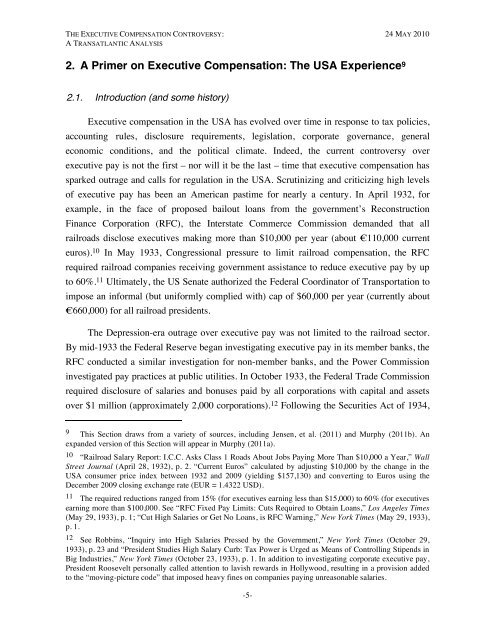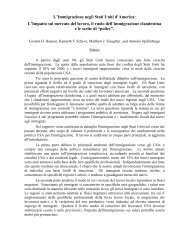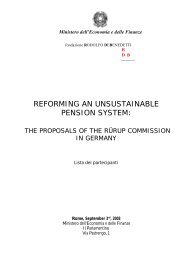The Executive Compensation Controversy - Fondazione Rodolfo ...
The Executive Compensation Controversy - Fondazione Rodolfo ...
The Executive Compensation Controversy - Fondazione Rodolfo ...
You also want an ePaper? Increase the reach of your titles
YUMPU automatically turns print PDFs into web optimized ePapers that Google loves.
THE EXECUTIVE COMPENSATION CONTROVERSY: 24 MAY 2010A TRANSATLANTIC ANALYSIS2. A Primer on <strong>Executive</strong> <strong>Compensation</strong>: <strong>The</strong> USA Experience 92.1. Introduction (and some history)<strong>Executive</strong> compensation in the USA has evolved over time in response to tax policies,accounting rules, disclosure requirements, legislation, corporate governance, generaleconomic conditions, and the political climate. Indeed, the current controversy overexecutive pay is not the first – nor will it be the last – time that executive compensation hassparked outrage and calls for regulation in the USA. Scrutinizing and criticizing high levelsof executive pay has been an American pastime for nearly a century. In April 1932, forexample, in the face of proposed bailout loans from the government’s ReconstructionFinance Corporation (RFC), the Interstate Commerce Commission demanded that allrailroads disclose executives making more than $10,000 per year (about €110,000 currenteuros). 10 In May 1933, Congressional pressure to limit railroad compensation, the RFCrequired railroad companies receiving government assistance to reduce executive pay by upto 60%. 11 Ultimately, the US Senate authorized the Federal Coordinator of Transportation toimpose an informal (but uniformly complied with) cap of $60,000 per year (currently about€660,000) for all railroad presidents.<strong>The</strong> Depression-era outrage over executive pay was not limited to the railroad sector.By mid-1933 the Federal Reserve began investigating executive pay in its member banks, theRFC conducted a similar investigation for non-member banks, and the Power Commissioninvestigated pay practices at public utilities. In October 1933, the Federal Trade Commissionrequired disclosure of salaries and bonuses paid by all corporations with capital and assetsover $1 million (approximately 2,000 corporations). 12 Following the Securities Act of 1934,9 This Section draws from a variety of sources, including Jensen, et al. (2011) and Murphy (2011b). Anexpanded version of this Section will appear in Murphy (2011a).10 “Railroad Salary Report: I.C.C. Asks Class 1 Roads About Jobs Paying More Than $10,000 a Year,” WallStreet Journal (April 28, 1932), p. 2. “Current Euros” calculated by adjusting $10,000 by the change in theUSA consumer price index between 1932 and 2009 (yielding $157,130) and converting to Euros using theDecember 2009 closing exchange rate (EUR = 1.4322 USD).11 <strong>The</strong> required reductions ranged from 15% (for executives earning less than $15,000) to 60% (for executivesearning more than $100,000. See “RFC Fixed Pay Limits: Cuts Required to Obtain Loans,” Los Angeles Times(May 29, 1933), p. 1; “Cut High Salaries or Get No Loans, is RFC Warning,” New York Times (May 29, 1933),p. 1.12 See Robbins, “Inquiry into High Salaries Pressed by the Government,” New York Times (October 29,1933), p. 23 and “President Studies High Salary Curb: Tax Power is Urged as Means of Controlling Stipends inBig Industries,” New York Times (October 23, 1933), p. 1. In addition to investigating corporate executive pay,President Roosevelt personally called attention to lavish rewards in Hollywood, resulting in a provision addedto the “moving-picture code” that imposed heavy fines on companies paying unreasonable salaries.-5-









